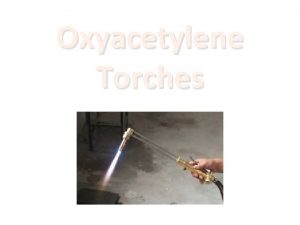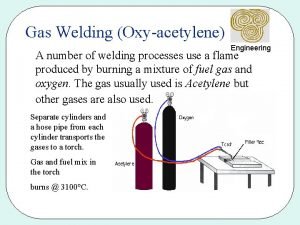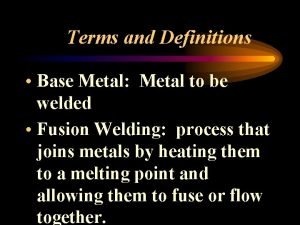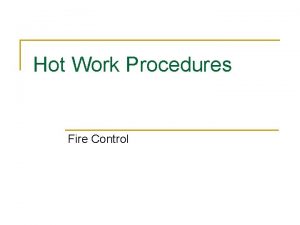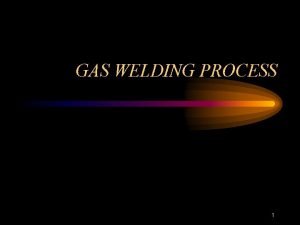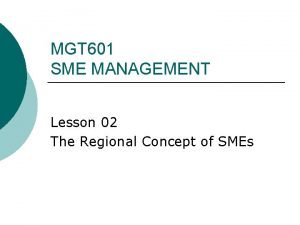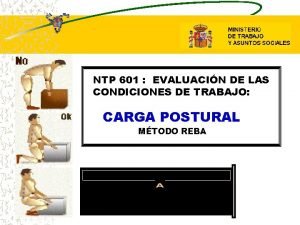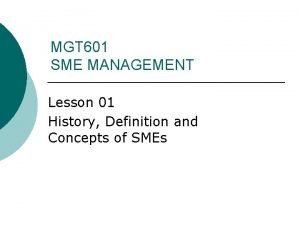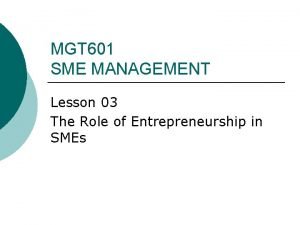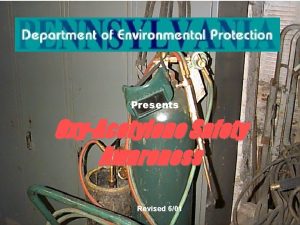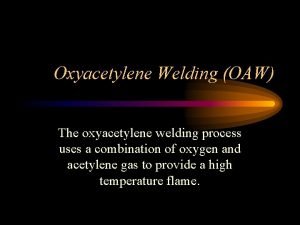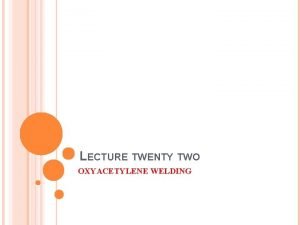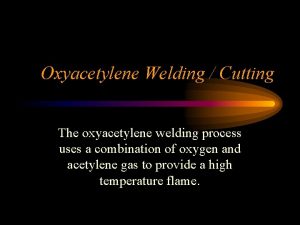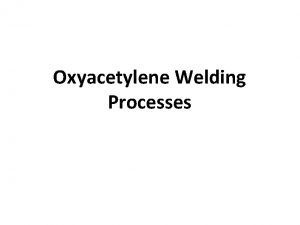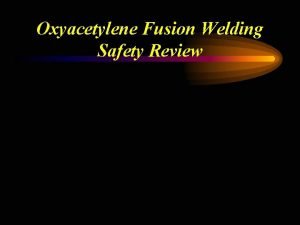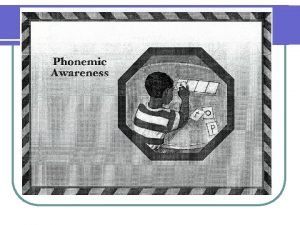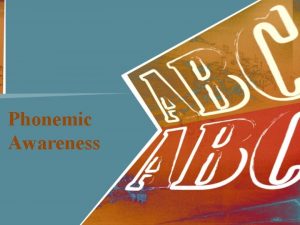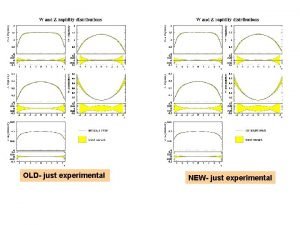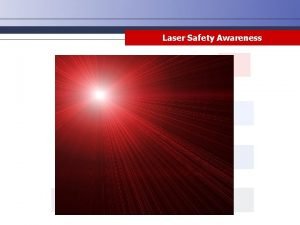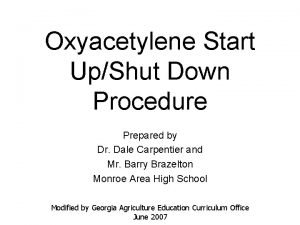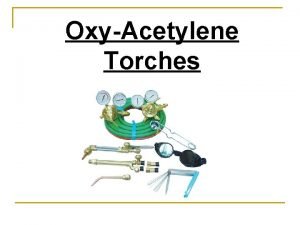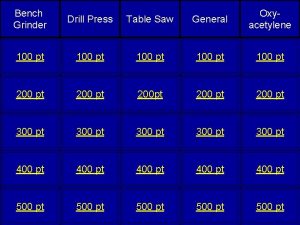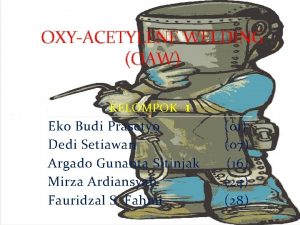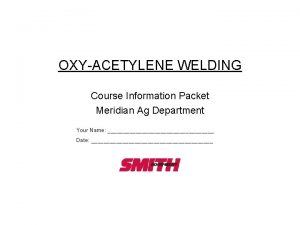Presents OxyAcetylene Safety Awareness Revised 601 Just a



























- Slides: 27

Presents Oxy-Acetylene Safety Awareness Revised 6/01

Just a note • This program is informational only and does not certify or qualify any persons in the use of Oxy-Acetylene burning or welding. • For the proper use of your equipment, please contact your supplier or manufacturer

Something to think on…… Every time you use the oxy-acetylene equipment , if certain safety guidelines are not followed, it would be the same as handling live explosives ready to go off……. Now let’s talk about the gases

What is Oxygen • Remember, oxygen is not air • There is approximately 21% oxygen in normal air • Oxygen is found naturally in the atmosphere • • It is produced industrially by distilling air below it’s freezing point Pure oxygen does not burn or explode • Oxygen is an “accelerant” , it causes every thing it comes in contact with to burn hotter and faster • Air has a vapor density of 1. 000, Oxygen is heavier than air (1. 105) This means if a oxygen bottle is leaking, the gas will settle in low areas before diffusing back into the atmosphere. • 30% oxygen in the atmosphere will cause things to burn or explode 8 times faster

Never use oxygen………. • in pneumatic tools- the oil and the gas pressure friction cause a fire or explosion • in oil pre-heating burners- these burners are set to burn with 21% oxygen to air ratio • to start internal combustion engines- gasoline is flammable enough with 21% oxygen available • to blow out pipelines- Leftover flammable or combustible vapors may still be present to cause an explosion • to dust off clothing or work area- the oxygen will remain present in the cloth fibers causing them to be more flammable • to create pressure • for ventilation • Remember, oxygen is not air

How are oxygen bottles constructed • • • Usually of steel construction 244 cu. ft is standard size (K size) 2000 to 2600 psi Hollow in construction An electric arc can cause an oxygen bottle to explode (the carbon in the steel will atomize into a fuel) • The orifice at the top of the bottle is the diameter of the lead in a pencil ( if the bottle top is damaged, the bottle can become projectile causing injury or property damage • Never allow a tank to go empty (this may allow acetylene to travel into the oxygen lines or bottle • Keep free from oil and grease

What is acetylene • Acetylene is a compound of Hydrogen and Carbon (C 2 H 2) a member of the hydrocarbon gases • Explosive range is 3. 0 to 93% • Needs only 10% of oxygen to ignite • Produced when calcium carbide is mixed with water • It is an unstable gas, will violently decompose when in a pure state above 15 psi • Has a burning temperature of 4, 600 o F, 5, 700 o F when burned with oxygen • Auto-ignition temperature is 763 o - 824 o F, this means if acetylene reaches 30 psi in a free state, it can explode by itself without a spark or flame being present • Remember, acetylene is a very dangerous gas

Why doesn’t acetylene explode in the bottle • Acetylene burns in air readily, and is most safely handled/stored in cylinders filled with crushed firebrick wet with acetone. • Acetylene happens to dissolve readily into acetone, and the dissolved gas is no longer in contact with gaseous O 2 (which does not tend to dissolve in acetone) and therefore is not as prone to decomposition by O 2. • The firebrick also helps by minimizing the free volume of the cylinder, cooling and controlling any thermal decomposition before it gets out of control (each decomposition of acetylene gives off heat). • Acetylene cylinders must, therefore, be refilled only by authorized gas distributors. Acetylene cylinders must never be transfilled.

How are acetylene bottles constructed • Usually are steel construction • Filled with a porous material to allow the acetone to dissolve the acetylene, which makes it stable • Porous filler(8 -10%), Acetone(42%) • Acetylene gas(36%), • Reserve volume-70 o F(10 -12%) • Never allow a tank to go empty – Oxygen may back pressure into the bottle • Comes in various sizes • Must always be stored upright – This prevents the acetone and acetylene from separating • Should not be stored below freezing – Acetone may come out instead of acetylene and may clog the regulators

Care & maintenance of the Gas Regulators The internal working parts of the regulator are precision units. Only qualified technicians should clean or repair a regulator The Low pressure gauge Indicates the delivery pressure to the hoses & torch The Pressure adjusting screw Turning clockwise allows the gas allows to flow Turning counterclockwise reduces or stops the gas flow The High pressure gauge Indicates the pressure from tank The Inlet Connections Oxygen are right hand thread/Acetylene are left hand thread Keep free of oil, grease, & dirt

Some more info on regulators Warning -Always keep the regulator free of oil, grease and other flammable substances Never use oil or grease on the regulator, cylinder or manifold connection DO NOT change the inlet connection on a regulator in an attempt to use the regulator for a different gas service Never stand in front or behind a regulator when opening the cylinder valve

Backfires and flashbacks • Backfires occur when the torch flame burns back into the torch tip and is extinguished with a loud pop. • They occur either because the torch tip touched the work or because of insufficient gas pressure. • They are generally harmless. However, flashbacks are more serious when the flame front does not extinguish, but burns back sometimes beyond the mixing chamber, through the hoses, and even into regulator and supply. • A common inside diameter of oxy-fuel gas hose is 1/4 inch. If you calculate the volume of 100 feet of hose with an inside diameter of 1/4 inch, this means, should oxygen enter the fuel gas hose or should fuel gas enter the oxygen hose, a mixed gas explosion with the force potential of 20 sticks of dynamite could occur.

Check valves • The purpose of an internal check valve is to reduce the possibility of reverse flow gas. • It is not intended to act as a fire stop! • Ensure that the internal check valves are working properly by testing at least every six months, more often if the hoses are frequently removed from the torch. Spring activated Gas flow Flow of gas keeps valve open Once flow pressure decreases, valve will closes preventing back flow of gas

Flashback arrestors • Flashback arrestors are designed to prevent a flashback from reaching upstream equipment. • They offer added safety and often include reverse flow check valves in a single unit Torch handle Flame path is extinguished by meshed material inside

The Hoses • The hoses are usually color coded, but not always – Oxygen(green) – Acetylene(red) – Be careful not to use other hoses, such as air lines, LP gas, etc. • They are neoprene over braided inner section – Be careful around sharp objects, they can be cut very easily • They are constructed of flame retardant materials, but will burn if there is a flashback or exposed to sustained heat • Hoses are graded – Make sure you are using the right hose for the right gas

More hose stuff • Keep welding hoses clear of any failing metal, slag or sparks. • Never allow hoses to become coated with oil, grease or dirt. Such coatings could conceal damaged areas. • Examine the hoses before attaching to welding torch handle or regulators. • If cuts, burns, worn areas or damaged fittings are found, replace the hose. • Completely replace welding hose if it contains multiple splices or when cracks or severe wear is noticed.

Torch handle Control valve & body”Y” Barrel Torch head

Torch cutting attachment There must always be two o -rings on the cone end. The absence or damage of either of these o-rings allows premixing and leaks of oxygen and fuel gases. This can lead to flashback within the torch handle.

What size cutting-tip do I need? The type of torch you are using and the thickness of material being cut determine the proper size cutting-tip for use in oxyacetylene flame cutting • Always make sure your equipment is rated for the size tip you have selected. • A tip with too much capacity for the equipment can starve or choke the tip. This causes overheating of the head and a flashback may result. • A damaged seating surface on either the tip or the head can create a dangerous condition, resulting in a fire or flashback. This may damage the cutting attachment. • If the seating surface of a tip becomes damaged, DO NOT use it. Discard the damaged tip. • If the head requires repair, take the torch to a qualified repair technician.

What tip sizes do I use for oxy-acetylene welding and what pressures do I set on my regulators? Tip sizes and gas regulator settings are dependent on the thickness of the material to be welded and the type torch being used Always refer to the manufacture’s supplied cutting chart for the cutting tips you are using. Remember, if you do not use the proper oxygen to acetylene ratio, you may cause an accident, at the very least you will waste gas, which costs $$$$.

Cutting tips and nozzles • Never starve or choke a multi-flame heating nozzle. This causes overheating of the head and a flashback may result. • Should a flashback occur (flame disappears and/or a hissing sound is heard, the flame is burning inside the nozzle), immediately turn off the oxygen valve on the torch handle. Then, turn off the fuel valve. • Allow the nozzle to cool before using. • If a flashback reoccurs, have the apparatus checked by a qualified technician before using again.

Laws & Regulations for Oxy-Acetylene Use Link to MSHA Regulations Link to OSHA Requirements Link to Pennsylvania State Requirements

Let’s Finish With Some Final General Safety Tips • Never allow oxygen to contact oil, grease or other flammable substances • Never mix brands • Purge the lines before and after usage • Always wear protective clothing • Use proper eye protection

If flashback occurs, immediately turn off the O 2, then the acetylene, and allow unit to cool Always work in a well ventilated area Always light the acetylene first Oxygen cylinders must be opened the whole way Use an approved striker, never use matches or cigarette lighter Use the proper regulator for each specific gas Only qualified technicians should repair a regulator Keep regulators free of oil, grease and other flammable substances

General Safety Tips Keep regulators free of oil, grease and other flammable substances Check valves stop reverse gas flow, they do not act as a fire stop Never starve a tip, this can cause a flashback Always keep cylinders in an upright position Never stand in front or behind a regulator when opening the cylinder valve Do not open acetylene valve more than 1 1/2 turns Always make sure area is safe and flammable free

Safety Checklist for Getting Started What is the necessary safety equipment you need? • Proper Eye protection • Appropriate gloves • Clothing free of grease & oil • Clean work area • Proper Task Training • Fire extinguisher

Thank you and Be Careful
 Oxyacetylene torches
Oxyacetylene torches Temperature of acetylene flame
Temperature of acetylene flame Striker welding definition
Striker welding definition The correct shutoff procedure for an oxyacetylene torch is:
The correct shutoff procedure for an oxyacetylene torch is: Define oxy-acetylene flame
Define oxy-acetylene flame Privacy awareness and hipaa awareness training cvs
Privacy awareness and hipaa awareness training cvs Did paris love juliet give evidence to support your answer
Did paris love juliet give evidence to support your answer Pgc 601
Pgc 601 Http 601
Http 601 601(b)(10)
601(b)(10) Sme management definition
Sme management definition Ek601
Ek601 Linear regression loss function
Linear regression loss function Usine peugeot
Usine peugeot Nr 601 test bank
Nr 601 test bank Werribee italian social club
Werribee italian social club Pgc 601
Pgc 601 Ntp 601
Ntp 601 Tcp over wireless in mobile computing
Tcp over wireless in mobile computing Backpropagation logistic regression
Backpropagation logistic regression Mgt 601
Mgt 601 601 pro
601 pro Mgt 601
Mgt 601 Hino 601
Hino 601 Pgc 601
Pgc 601 601(b)(10)
601(b)(10) 601 south belvidere street
601 south belvidere street Pgc 601
Pgc 601
